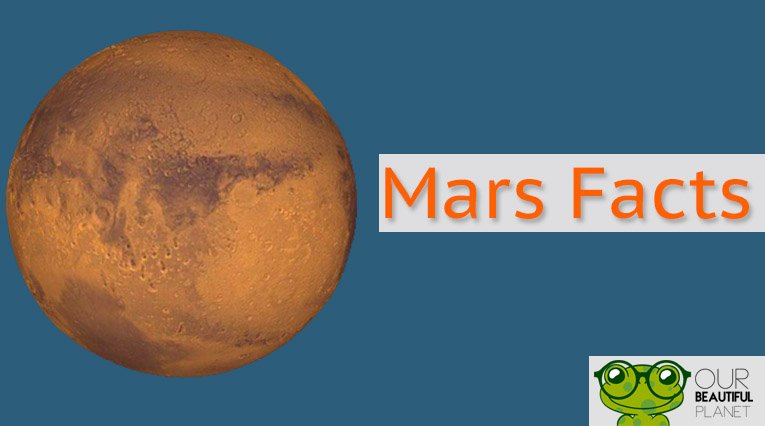Last modified on April 9th, 2020 at 12:48 pm
Facts About Mars: Life On The Red Planet
Table of Contents:
Current and Previous Life
Presence of Liquid Water
Temperature
Length of A Martian Day
Martian Moons
Gravity
How Big Is Mars
The Tallest Mountain In The Solar System
Traveling to Mars
While Mars may be big in the news lately, it is actually the second smallest planet in our Solar System. Due to its promising ability to potentially house life, scientists have been paying extra attention to The Red Planet as of recently.
There are ongoing investigations that are assessing the overall habitability of Mars, and whether or not it may have been home to life in the past.
Due its proximity to Earth and notable key similarities such as a similar tilt, which creates seasons, Mars is the most promising planet within reach for future human life.
SpaceX has already made plans to eventually transport 1 million people to Mars via their Interplanetary Transport System, which will be able to carry at least 100 people to Mars per flight.
At a conference in Mexico, SpaceX Founder, Elon Musk announced that he plans to have a self-sustaining colony on Mars within the next 50-100 years.
“What I really want to do here is to make Mars seem possible – make it seem as though it’s something that we could do in our lifetimes, and that you can go” – Elon Musk, SpaceX Founder.
1. Was There Ever Life On Mars?
The Short Answer: Probably.
The possibility of current or previous life on Mars is a subject of significant interest to astrobiology. This is mostly due to the numerous similarities Mars has to Earth. Scientists have been searching for definitive proof for centuries, but so far have only found somewhat convincing evidence.
In recent years, scientists have claimed that there is undeniable proof that Mars once housed life. NASA indicated in a recent study that Mars could have once housed a variety of bugs that flourished in shallow lakes and pools.
Additionally, the NASA Curiosity rover has recorded “burps” of methane. While at first this may sound underwhelming; methane is often times produced by bacteria. Living organisms in fact produce most methane that is found on Earth.
This being said, life as we know it may have a rough time developing and thriving on Mars. While Martian soils may not be overly toxic, they are bathed in radiation and completely frozen. The radiation that is on Mars’ surface has been determined to be so high that any biological organisms would not be able to survive without protection.
Subterranean environments may have a more promising outlook though. Volcanism from the past formed large aquifers where liquid water could have existed. With liquid water and geothermal heat as protection, this environment is potentially habitable.
2. Is There Water On Mars
The Short Answer: Yes, but it’s frozen.
For life as we know it, liquid water is absolutely necessary. Due to freezing temperatures, liquid water is not possible on Mars except at its lowest elevation. Even at these elevations, the water would not remain liquid for long, freezing in a matter of hours.
The majority of Martian water exists as ice located at the polar ice caps, and under the surface. There are no bodies of water currently on Mars due to extremely low temperatures, and atmospheric pressure.
Despite all of this, roughly 3.8 billion years ago Mars had a much denser atmosphere, and higher temperatures. This leads us to believe that large amounts of water once flowed on the surface of Mars.
3. What Is The Temperature on Mars?
The Short Answer: Uncomfortably frigid.
Mars is not a place for the faint of heart. It is a harsh, frigid environment. It is much, MUCH colder than earth, but that is to be expected, as it is a whopping 140 million miles further from the Sun than Earth is.
Additionally, the atmosphere on Mars is approximately 100 times thinner than what we have on Earth. The atmosphere acts as a sort of thermal blanket, helping the planet retain heat.
On average, Mars is about -80F (-60C). During the winter season, temperatures can get as low as -195F (-125C)
4. How Long Is A Day On Mars?
The Short Answer: About the same as on earth.
Many people are mistaken in assuming that a day on Mars is drastically longer or shorter than on Earth. While Mars’ years are longer (the time it takes for Mars to rotate around the sun), a typical day (time it takes for 1 planetary revolution) on Mars is only 40 minutes longer than a day on Earth.
When compared to other planets even just in our solar system alone, this similarity is astounding. Jupiter, for example, has days that are just 9 hours and 55 minutes long, and a day on Venus lasts as long as 116 days back on Earth.
5. How Many Moons Does Mars Have?
The Short Answer: 2, Deimos and Phobos.
Unlike Earth, Mars has two moons. Both moons were discovered in 1877, and are named after characters in Greek Mythology.
Phobos
Phobos is the innermost of Mars’ two moons. Phobos is the larger of Mars’ two moons, with an average radius of around 7 miles. We say average, because unlike our earthly moon, Phobos has an irregular shape.
Phobos is named after the Greek God Phobos, which was the personification of horror. It orbits 3,700 miles from the surface of Mars, which is closer to its planet than any other planetary moon known to science.
Deimos
The smaller of Mars’ two moons, Deimos has a radius of 3.9 miles. As with Phobos, Deimos is also named after a Greek God. In Greek Mythology, Deimos is the twin brother of Phobos.
6. What Is Gravity Like On Mars?
The Short Answer: About 38% of Earth’s.
If you were to land on Mars, other than the chilling temperatures, the difference in gravity would be one of the first things you notice. Gravity on Mars is 62% lower than on Earth. This means that you will feel 62% lighter on Mars than on Earth.
The difference in gravity can be attributed to a number of different factors including mass, density, and radius. Mars has similar surface land area as Earth, but is has significantly less mass. Mars has roughly 11% of Earth’s mass.
7. How Big Is Mars?
The Short Answer: 53% Smaller than Earth.
Using diameter as a source of measurement, Mars is the second smallest planet in the solar system; only Mercury is smaller. Mars is roughly 53% of the size of earth.
8. What Is Olympus Mons?
Short Answer: The largest mountain/volcano in the solar system.
The Martian volcano, Olympus Mons is famous for being the largest mountain/volcano in the solar system. It stands nearly 22 km (13.6 mi) high. While it is the youngest of the large volcanos on Mars, it is by far the most impressive. To put it into perspective, Olympus Mons is roughly 2.5 times the height of Mt. Everest.
9. How Long Would It Take To Get to Mars?
Short Answer: 39-289 days, it depends.
So, how far is Mars from Earth, and realistically, how long will it take to get there? The distance between Earth and Mars is dependent on the time at which you would like to travel. At its closest, Mars is 33.9-34.8 million miles away from Earth.
Earth and Mars are furthest apart from each other when they are both at their furthest relative distance to the Sun. When this occurs, Earth and Mars are roughly 250 million miles away from each other. So how long will does it take to travel that distance?
At this point in time, the fastest space probe ever launched (NASA’s New Horizon Mission to Pluto) traveled at 36,000 mph. At this speed, you’re looking at a travel time of at least 39 days, and at most 289 days, depending on how far apart the planets are at the time of travel.
Depending on when you start the journey, this straight-line measurement may not be exactly accurate. In fact, traveling to Mars when it is it’s furthest from Earth would mean traveling through the sun, which isn’t feasible. In this scenario, you would have to move into orbit around the Sun in order to make it to Mars.
Mars Missions
Here’s a list of recent missions to Mars and how long they took:
• Mariner 4, the first spacecraft to go to Mars (1964 flyby): 228 days
• Mariner 6 (1969 flyby): 155 days
• Mariner 7 (1969 flyby): 128 days
• Mariner 9, the first spacecraft to orbit Mars (1971): 168 days
• Viking 1, the first U.S. craft to land on Mars (1975): 304 days
• Viking 2 Orbiter/Lander (1975): 333 days
• Mars Global Surveyor (1996): 308 days
• Mars Pathfinder (1996): 212 days
• Mars Odyssey (2001): 200 days
• Mars Express Orbiter (2003): 201 days
• Mars Reconnaissance Orbiter (2005): 210 days
• Mars Science Laboratory (2011): 254 days
Colonizing Mars
More than any other planet, Mars has the most hope for eventual human colonization. With progress made by SpaceX alone, we could be colonizing Mars in the next 50-100 years.
Want to go to make history and be one of the first to go to Mars? Check out the qualifications here!
I have been a nature enthusiast since I was a small girl. My background is in online marketing and website development. It only makes sense to merge my love for nature with my skills in online marketing to help spread awareness, and appreciation for Our Beautiful Planet.




